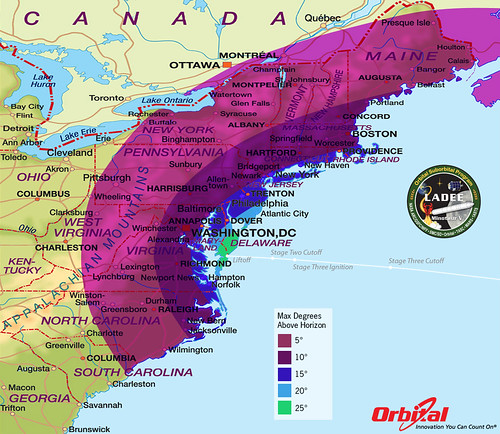LADEE Launch Viewing Map – Elevation

Image by NASA Goddard Photo and Video
This map shows the maximum elevation (degrees above the horizon) that the Minotaur V rocket will reach depending on your location along the east coast. The further away you are from the launch site, the closer to the horizon the rocket will be. As a reference, when you look at your fist with your arm fully outstretched, it spans approximately 10 degrees. Thus if you are in Washington, DC the highest point the Minotaur V will reach is approximately 13 degrees above the horizon, or just slightly more than a fist’s width. The contours shown stop below 5 degrees. It is unlikely that you’ll be able to view the rocket when it is below 5 degrees due to buildings, vegetation, and other terrain features.
Credit: Orbital
—–
What is LADEE?
The Lunar Atmosphere and Dust Environment Explorer (LADEE) is designed to study the Moon’s thin exosphere and the lunar dust environment. An "exosphere" is an atmosphere that is so thin and tenuous that molecules don’t collide with each other. Studying the Moon’s exosphere will help scientists understand other planetary bodies with exospheres too, like Mercury and some of Jupiter’s bigger moons. The orbiter will determine the density, composition and temporal and spatial variability of the Moon’s exosphere to help us understand where the species in the exosphere come from and the role of the solar wind, lunar surface and interior, and meteoric infall as sources. The mission will also examine the density and temporal and spatial variability of dust particles that may get lofted into the atmosphere.
The mission also will test several new technologies, including a modular spacecraft bus that may reduce the cost of future deep space missions and demonstrate two-way high rate laser communication for the first time from the Moon.
LADEE now is ready to launch when the window opens on Sept. 6, 2013. Read more: www.nasa.gov/ladee
NASA Goddard Space Flight Center enables NASA's mission through four scientific endeavors: Earth Science, Heliophysics, Solar System Exploration, and Astrophysics. Goddard plays a leading role in NASA's accomplishments by contributing compelling scientific knowledge to advance the Agency's mission.
Follow us on Twitter
Like us on Facebook
Find us on Instagram
Tags:elevation, LADEE, Launch, viewing


0 comments:
Post a Comment